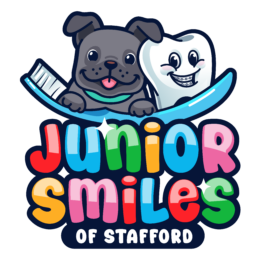Concussed Tooth in Your Child? A Pediatric Dentist’s Step-by-Step Guide for Stafford Parents
There are few things more heart-stopping for a parent than seeing their child fall or bump their mouth. One moment they’re running happily at the playground, and the next, you’re rushing to comfort them as tears stream down their face. In those moments, your mind races: Is that tooth broken? Do we need to go to the ER? Should I call the dentist right now?
At Junior Smiles of Stafford, we’ve cared for hundreds of families through dental emergencies just like this. We know how frightening it can feel, and our goal is to provide you with a clear, calm plan. This guide walks you step by step through what to do if your child has a concussed tooth, so you can feel reassured and confident that help is just a phone call away.
First, Take a Breath. Here’s What to Do in the Next 10 Minutes
“The first few minutes are about comfort and assessment. Stay calm, and your child will feel calmer too.” — Dr. Azar, Junior Smiles of Stafford
The very first thing you should do is comfort your child. Hold them, speak softly, and reassure them that they are safe. Once they begin to settle, check for bleeding around the lips and gums. If you see blood, gently press a piece of clean gauze or a soft cloth against the area.
To reduce swelling, apply a cool compress or an ice pack wrapped in a towel to the outside of their cheek. Offer your child a sip of cool water, but ask them to simply let it sit in their mouth and dribble out, rather than spitting forcefully, which can worsen bleeding. For the rest of the day, stick to soft foods like yogurt or applesauce that won’t put extra stress on the tooth.
In these early moments, your priority is to keep your child comfortable and avoid additional trauma.
What Is a “Concussed Tooth”? An Injury You Can’t Always See
One of the most confusing parts of this type of injury is that nothing looks obviously wrong. The tooth may not be chipped, cracked, or loose — but it still hurts. Dentists call this a “concussed tooth.”
The best way to picture it is like a sprained ankle. When your child twists their ankle, the bone is fine, but the ligaments and tissues around it are bruised. A concussed tooth is similar: the tooth itself hasn’t broken, but the ligament that holds it in place has been injured. This can cause soreness, tenderness when biting, or even subtle changes in how the tooth feels when touched.
Key Warning Signs: When to Call Our Stafford Office Immediately
Not all tooth bumps are created equal. Sometimes they only require observation, and other times they need urgent care.
Signs That Mean “Call Us Right Now”
If your child is experiencing severe bleeding that doesn’t stop with gentle pressure, if a tooth has shifted out of place or feels very loose, or if a piece of the tooth has broken off, call us right away. Just as importantly, if your child is dizzy, vomiting, or showing any symptoms of a head concussion, they need immediate medical attention.
If you see any of these signs, call our Stafford office immediately at [Phone Number] for an emergency appointment.
Signs That Mean “Book an Appointment This Week”
Other changes may not feel like emergencies but still deserve prompt attention. If the tooth begins to darken to gray, black, or pinkish-red, if your child complains of ongoing pain or sensitivity, or if you notice swelling or a small pimple-like bump on the gum above the tooth, these are signs the nerve may be affected.
👉 Seeing these symptoms? https://juniorsmilesofstafford.com/contact/
Baby Teeth vs. Permanent Teeth: Why the Treatment Goals Are Different
Parents are often surprised to learn that how we handle a concussed baby tooth is very different from how we manage a concussed permanent tooth.
If Your Child’s Baby Tooth Is Concussed
Our main concern is protecting the permanent tooth developing beneath it. Often, the safest path is careful observation. If infection develops, we may recommend removing the baby tooth — not because the tooth can’t be saved, but because protecting the underlying adult tooth is the priority.
If Your Child’s Permanent Tooth Is Concussed
The focus shifts to saving the tooth itself. This means carefully monitoring the nerve’s health over time. In some cases, if the nerve is damaged, treatments such as a root canal may be needed to preserve the tooth for life.
At Junior Smiles of Stafford, our approach follows the evidence-based guidelines of the American Academy of Pediatric Dentistry (AAPD), ensuring your child receives the highest standard of care.
Answering Your Top Questions About Tooth Injuries
Why does my child’s tooth feel weird after hitting their head?
Teeth are suspended in tiny shock absorbers called periodontal ligaments. When a tooth gets bumped, those ligaments get bruised and inflamed, creating that “weird” or tender feeling.
How long does a concussed tooth take to heal?
Most sensitivity improves within days to a couple of weeks. However, color changes can take longer to appear. Monitoring over the next few months is key.
What’s the difference between a concussion and a subluxation?
A concussion means the tooth is bruised but not loose. Subluxation means the tooth is both bruised and slightly mobile. Both require monitoring, but subluxation may carry a higher risk of long-term complications.
👉 Learn more about our approach on our https://juniorsmilesofstafford.com/for-patients/
Parent’s Guide: A “Watchful Waiting” Checklist
To make monitoring easier, we’ve created a simple daily and weekly checklist for parents.
- Daily (First Week): Note pain levels, sensitivity when eating, and any changes in reaction to hot or cold.
- Weekly: Compare the tooth’s color using a photo from Day 1. Look for gum swelling or new complaints from your child.
Preventing Dental Injuries in Active Stafford Kids
Of course, the best emergency is the one that never happens. Many concussed teeth result from sports, playground falls, or accidents at home. Custom-fitted mouthguards for young athletes, baby-proofing sharp corners on tables, and setting clear safety rules for play can dramatically reduce risk.
If your child plays sports, ask us about our custom mouthguard service. These offer superior protection compared to store-bought guards and are made to fit your child comfortably.
Your Child’s Smile Is Our Priority at Junior Smiles of Stafford
Dental injuries can feel overwhelming, but you don’t have to face them alone. At Junior Smiles of Stafford, our pediatric specialists are here to guide your family through emergencies with expertise, compassion, and a kid-friendly touch.
💬 “No parent should have to wonder what to do when their child is in pain. We’re here to provide clear answers and gentle care — every step of the way.” — Dr. [Lead Dentist’s Name]📞 Don’t wait and wonder. Call us now: (540) 699-2441
👉 Ready to schedule a check-up? https://juniorsmilesofstafford.com/contact/
📍 Visit our kid-friendly office: 963 Garrisonville Rd #103 Stafford, VA

